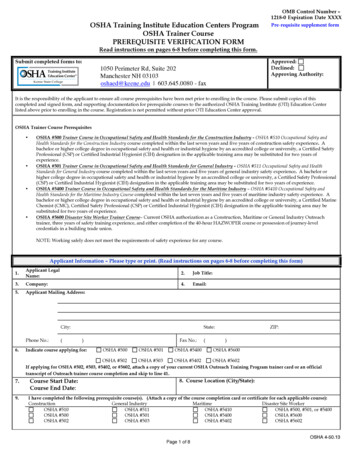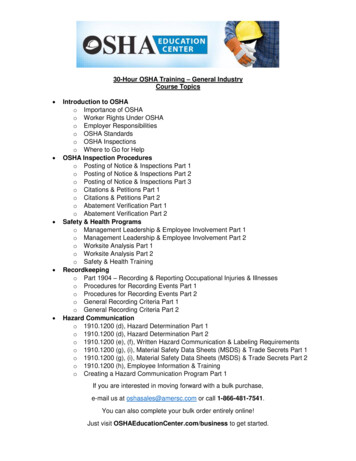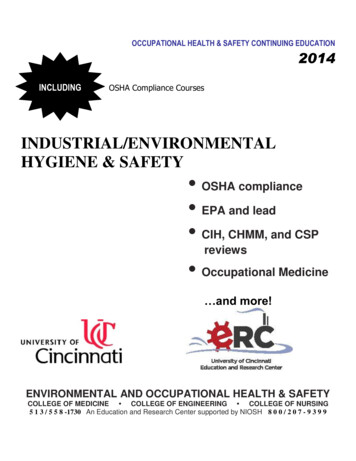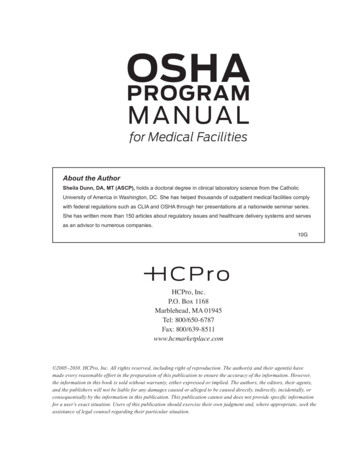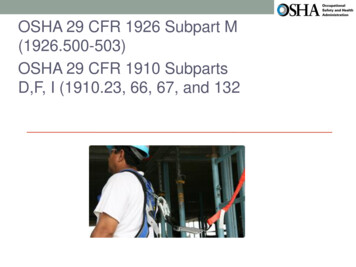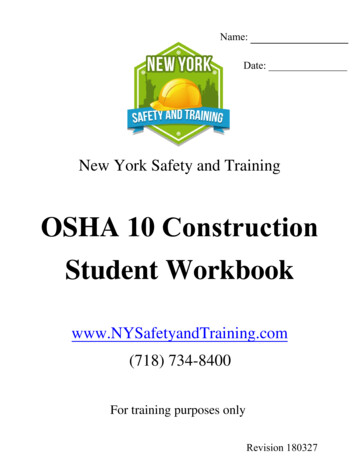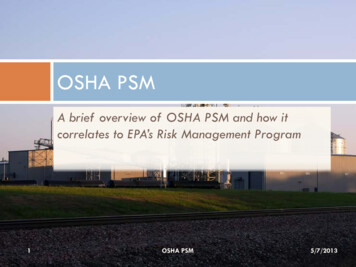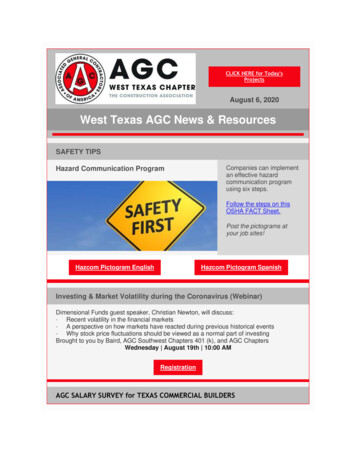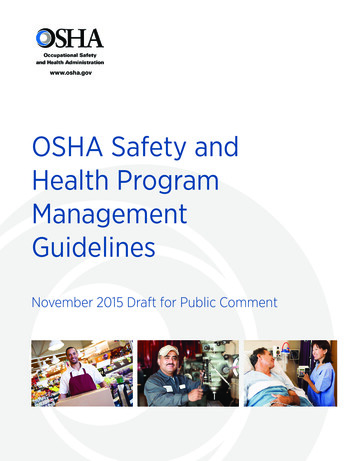
Transcription
www.osha.govOSHA Safety andHealth ProgramManagementGuidelinesNovember 2015 Draft for Public Comment
Relationship to the 1989 Guidelines and Existing Legal RequirementsThese guidelines update and replace the Occupational Safety and Health Administration’s (OSHA’s) voluntary Safety and Health Program Management Guidelines, first published in 1989.1 They build on lessonslearned about successful approaches and best practices under OSHA programs such as the VoluntaryProtection Programs (VPP) and the Safety and Health Achievement Recognition Program (SHARP). Theguidelines are also consistent with many national and international consensus standards. 2To help you implement the guidelines, Appendix A: Implementation Tools and Resources describes severalavailable tools and resources. OSHA will add to these resources through the guidelines website atwww.osha.gov/shpmguidelines.Appendix B: Relationship of Guidelines to Existing OSHA Standards identifies existing OSHA standards thatinclude provisions similar or identical to action items in these guidelines. These guidelines do not changeemployers’ obligations to comply with the requirements of any OSHA standard.The guidelines are advisory and informational in content. They are not new standards or regulations; theyalso do not create any new legal obligations or alter existing obligations created by OSHA standards,OSHA regulations, or the Occupational Safety and Health Act of 1970 (OSH Act). Pursuant to the OSH Act,employers must comply with safety and health standards and regulations issued and enforced either byOSHA or by an OSHA-approved State Plan. In addition, the OSH Act’s General Duty Clause, Section 5(a)(1),requires employers to provide their workers with a workplace free from recognized hazards likely to causedeath or serious physical harm. Implementing a safety and health program in accordance with these guidelines can aid employers in their efforts to comply with the OSH Act.154 FR 3904–3916; January 26, 19892A comparison of these guidelines, the 1989 guidelines, OSHA voluntary programs, and other consensus standards is available on the OSHAwebsite at www.osha.gov/shpmguidelines.Draft for Public Comment
ContentsIntroduction.1Management Leadership.6Worker Participation.8Hazard Identification and Assessment. 11Hazard Prevention and Control. 16Education and Training. 19Program Evaluation and Improvement. 21Coordination and Communication on Multiemployer Worksites. 23Appendix A: Implementation Tools and Resources. 28Appendix B: Relationship of Guidelines to Existing OSHA Standards. 30Draft for Public Comment
OSHA Safety and Health Program Management GuidelinesINTRODUCTIONTHESE GUIDELINES provide employers, workers,and worker representatives3 with a sound, flexible framework for addressing safety and healthissues in diverse workplaces. They are intendedfor use in any workplace, but will be particularlyhelpful in small and medium-sized workplaces.The guidelines use a proactive approachto managing workplace safety and health.Traditional approaches are often reactive—thatis, problems are addressed only after a worker isinjured or becomes sick, a new standard or regulation is published, or an outside inspection findsa problem that must be fixed. These guidelinesrecognize that finding and fixing hazards beforethey cause injury or illness is a far more effectiveapproach.The concept of continuous improvement is key tothe guidelines. The idea is to begin with a basicprogram and simple goals and grow from there. Ifyou focus on achieving goals, monitoring performance, and evaluating outcomes, your workplacecan progress along the path to higher levels ofsafety and health achievement.The Benefits of Implementing These GuidelinesThe main goal of safety and health programs is to prevent workplace injuries, illnesses, and deaths, as wellas the suffering and financial hardship these events can cause for workers, their families, and employers.A study of small employers in Ohio found that workers’ compensation claims fell dramatically after workingwith OSHA’s SHARP program to adopt programs similar to those described in these guidelines.4 averagenumber of claimsDECREASED52%claimscost per claimaverage lost time per claimDECREASEDDEC RE AS E D80%87%(per milliondollars of payroll)DECREASED88%Source: Ohio Bureau of Workers’ Compensation (2011), Ohio 21(d) SHARP Program Performance Assessment.3For certain activities, worker participation is vital to the success of the program. In several places in these guidelines, OSHA refers not justto workers but also to their representatives, such as labor unions.4The Safety & Health Achievement Recognition Program (SHARP) recognizes small business employers who have used OSHA’s On-siteConsultation Program services and operate an exemplary injury and illness prevention program. For more information see .Draft for Public Comment1
OSHA Safety and Health Program Management GuidelinesINTRODUCTIONEmployers will find that implementing these guidelines also brings other benefits. The renewed or enhancedcommitment to safety and health and the cooperative atmosphere between management and workers havebeen linked to: Improvements in product, process, and service quality.Better workplace morale.Improved recruitment and retention.A more favorable image and reputation (among customers, suppliers, and the community).IMPLEMENTINGa safety & health programcan help employers avoid theINDIRECTCOSTSthat resultfromWORKPLACEINCIDENTSsuch asTIMELOSTdue to workstoppages andinvestigations,training and othercosts associated withREPLACINGINJUREDWORKERSLOSS ORand DAMAGE to material,machineryand property.These INDIRECT have been estimated2.7to be at least times theCOSTSDIRECTCOSTS55Leigh, J. P. (2011), Economic Burden of Occupational Injury and Illness in the United States. Milbank Quarterly, 89: 728–772.Draft for Public Comment2
OSHA Safety and Health Program Management GuidelinesINTRODUCTIONHow to Use the GuidelinesEach guideline section describes a core programelement (see Figure 1 on p. 4), followed byseveral action items. Each action item listsexamples of steps that employers and workerscan take to establish, implement, maintain, andimprove their safety and health programs. Youcan use the checklist referenced in Appendix A:Implementation Tools and Resources to track yourprogress and document how you have implemented (or will implement) each action item.protection, may require more formal and detailedprocesses.You should adapt these guideline recommendations to the particular needs and resources of yourworkplace. Guideline implementation will likelydiffer from workplace to workplace due to theunique circumstances present at each site.Drawing from lessons learned from successfulprograms, the guidelines emphasize the importance of worker participation. For a program tosucceed, workers and their representatives mustparticipate in developing and implementing allelements of the safety and health program. Thisemphasis on worker participation is consistent withthe OSH Act, OSHA standards, and OSHA enforcement policies and procedures, which recognizethe rights and roles of workers and their representatives in matters of workplace safety and health.Several action items described in these guidelinesrely on expertise and input that can come onlyfrom workers and worker representatives.While the action items are specific, they are notprescriptive. There may be several ways to implement each core element and action item. Yoursafety and health program can and should evolve.Experimentation, evaluation, and program changesare all part of the process.Injuries and illnesses occur in all types ofworkplace settings, from manufacturing andconstruction sites to hospitals and healthcarefacilities, offices, and other service industries.The preventive approaches described in theseguidelines work equally well across all industrialsectors and for small and large organizationsalike. Small employers may find that they can bestaccomplish the actions outlined in these guidelinesusing informal communications and procedures.Larger employers who have more complex workprocesses and hazards, or who wish to integratetheir program with existing management systemsfor production, quality control, and environmentalDraft for Public CommentEmployers and workers on “multiemployer”worksites (where workers of more than oneemployer are present) will want to review“Coordination and Communication onMultiemployer Worksites,” page 23. That sectiondescribes actions that host employers andcontractors, subcontractors, and temporarystaffing agencies (and their workers) should take.3
OSHA Safety and Health Program Management GuidelinesINTRODUCTIONCore Elements of the Safety and Health Program Management GuidelinesManagementLeadership Top management demonstrates its commitment to continuous improvement in safety andhealth, communicates that commitment to workers, and sets program expectations andresponsibilities. Managers at all levels make safety and health a core organizational value, establish safety andhealth goals and objectives, provide adequate resources and support for the program, and seta good example.WorkerParticipation Workers and their representatives are involved in all aspects of the program—includingsetting goals, identifying and reporting hazards, investigating incidents, and trackingprogress. All workers, including contractors and temporary workers, understand their roles andresponsibilities under the program and what they need to do to effectively carry them out. Workers are encouraged and have means to communicate openly with management and toreport safety and health concerns without fear of retaliation. Any potential barriers or obstacles to worker participation in the program (for example,language, lack of information, or disincentives) are removed or addressed.HazardIdentification andAssessment Procedures are put in place to continually identify workplace hazards and evaluate risks. An initial assessment of existing hazards and control measures is followed by periodicinspections and reassessments to identify new hazards.Hazard Preventionand Control Employers and workers cooperate to identify and select options for eliminating, preventing,or controlling workplace hazards. A plan is developed that ensures controls are implemented, interim protection is provided,progress is tracked, and the effectiveness of controls is verified.Education andTraining All workers are trained to understand how the program works and how to carry out theresponsibilities assigned to them under the program. All workers are trained to recognize workplace hazards and to understand the controlmeasures that have been implemented.ProgramEvaluation andImprovement Control measures are periodically evaluated for effectiveness. Processes are established to monitor program performance, verify program implementation,identify program deficiencies and opportunities for improvement, and take actions necessaryto improve the program and overall safety and health performance.Coordination andCommunication onMultiemployerWorksites The host employer and all contract employers coordinate on work planning and scheduling toidentify and resolve any conflicts that could impact safety or health. Workers from both the host and contract employer are informed about the hazards present atthe worksite and the hazards that work of the contract employer may create on site.Draft for Public Comment4
OSHA Safety and Health Program Management GuidelinesINTRODUCTIONFor More InformationFor more information about these guidelines,tools to help you implement them, and relatedtopics, see OSHA’s website at www.osha.gov/shpmguidelines. This Web page includes links totools developed by OSHA and others that canhelp employers and workers implement theseguidelines. Some of these tools and resources arelisted in Appendix A: Implementation Tools andResources.states and territories across the country, withpriority given to high-hazard worksites. On-siteConsultation services are separate from enforcement and do not result in penalties or citations.Consultants from state agencies or universities work with employers to identify workplacehazards, provide advice on compliance with OSHAstandards, and help establish and improve theirsafety and health programs. To locate the OSHAOn-site Consultation Program nearest you, call1-800-321-6742 (OSHA) or visit ��s On-site Consultation Program offersfree and confidential safety and health servicesto small and medium-sized businesses in allDraft for Public Comment5
OSHA Safety and Health Program Management GuidelinesMANAGEMENT LEADERSHIPMANAGEMENT provides the leadership, vision, andresources needed to implement an effective safetyand health program. Management leadershipmeans that business owners, CEOs, managers, andsupervisors at all levels: Are fully committed to continuously improvingworkplace safety and health performance. Make worker safety and health a core organizational value. Provide sufficient resources to implement thesafety and health program. Visibly demonstrate and communicate theirsafety and health commitment to workers andothers. Set an example through their own actions,such as wearing protective equipment whereit is required.Action item 1: C ommunicate your commitment to a safety and health programA clear, written policy helps you communicatethat safety and health is a primary organizationalvalue and is as important as productivity, profitability, product or service quality, and customersatisfaction. Communicate the policy to all workersand relevant stakeholders, including, asapplicable:Contractors, subcontractors, andtemporary workers at your worksite(s).Labor unions.Suppliers and vendors.Other tenants in a multi-tenant building.Visitors.Customers.How to accomplish it Establish a written policy signed by topmanagement describing the organization’scommitment to safety and health andpledging to establish and maintain a safetyand health program.Action item 2: Define program goals and expectationsHow to accomplish itBy establishing specific goals and objectives,management sets expectations for workers andfor the program overall. The goals and objectivesshould focus on specific actions that will improveworkplace safety.Draft for Public Comment Establish realistic, attainable, and measurable goals that demonstrate progress towardimproving safety and health. Develop plans to achieve the goals byassigning tasks and responsibilities to particular individuals, setting time frames, anddetermining resource needs.6
OSHA Safety and Health Program Management GuidelinesMANAGEMENT LEADERSHIP Communicate the goals and plans to yourworkers, as well as contractor, subcontractor, and temporary staffing agencyworkers.Action item 3: Allocate resourcesManagement provides the resources needed toimplement the safety and health program, pursueprogram goals, and address program deficiencieswhen they are identified.How to accomplish it Integrate safety and health into planning andbudgeting processes and align budgets withprogram needs. Estimate the resources needed to establishand implement the program. Allow time in workers’ schedules for fullparticipation in the program. Provide and direct resources (money andstaff time) to operate and maintain theprogram, meet safety and health commitments, and pursue program goals. Make arrangements to ensure that resourcessuch as first-aid and medical treatment areavailable if a worker is injured at work orsuffers a work-related illness.Note: Resource needs will vary depending on yourorganization’s size, complexity, and starting point inprogram development. Resource needs may includecapital equipment and supplies, staff time, training,access to information and tools (e.g., vendor information,Safety Data Sheets, injury/illness data, checklists, onlinedatabases), and access to safety and health experts,including OSHA’s free On-site Consultation Program (see“For More Information” in the “Introduction” section ofthese guidelines).Action item 4: Expect performanceManagement leads the program effort by establishing roles and responsibilities, setting a goodexample, and providing an open environment forcommunicating about safety and health. Ensure that top leadership and local management share the same safety and healthperformance goals and priorities. Set an example for workers by following thesame safety procedures you expect them tofollow. Establish ways for management and allworkers to communicate freely and oftenabout safety and health issues, without fearof retaliation.How to accomplish it Define and communicate responsibilities andauthorities for implementing and maintainingthe program and hold people accountable forperformance.Draft for Public Comment7
OSHA Safety and Health Program Management GuidelinesWORKER PARTICIPATIONWORKERS have much to gain from a successfulsafety and health program and the most tolose if the program fails. Workers often know themost about their jobs and any potential hazards.A safety and health program will be ineffectivewithout meaningful participation of workers and(if applicable) their representatives in establishingand operating the program.6Worker participation means that all workers,including contractors, subcontractors, and temporary staffing agency workers:against any employee because such employee has filedany complaint or instituted any proceeding under orrelated to [the OSH] Act or has testified or is about totestify in any such proceeding or because of the exerciseof such employee on behalf of himself or others of anyright afforded by [the OSH] Act.” Have opportunities to participate throughoutprogram design and implementation. Have access to information they need toparticipate effectively in the program. Are encouraged to participate in the programand feel comfortable reporting safety andhealth concerns.Note: Incentive programs for workers or managers thattie performance evaluations, compensation, or rewardsto low injury and illness rates can discourage injury andillness reporting. Point systems that penalize workersfor reporting injuries, illnesses, or other safety or healthconcerns have the same effect, as can mandatory drugtesting after reporting injuries. Effective safety and healthprograms recognize positive safety and health activities,such as reporting hazardous conditions or suggestingsafer work procedures.In addition, management identifies and eliminatesbarriers to worker participation in the program.Note: It is a violation of Section 11(c) of the OSH Act foran employer to “discharge or in any manner discriminateAction item 1: Encourage workers to report safety and health concernsWorkers are often best positioned to identifysafety and health concerns and program deficiencies, such as emerging workplace hazards, unsafeconditions, close calls/near misses, and actualincidents. By encouraging reporting and followingup promptly on all reports, employers can addressissues before someone gets hurt or becomes ill.6reports promptly. Reporting processes mayhave an anonymous component to reduceany fear of reprisal. Empower all workers to temporarily suspendor shut down any work activity or operationthey feel is unsafe.How to accomplish it Involve workers in finding solutions toreported issues. Establish a process for workers to reportinjuries, illnesses, close calls/near misses, andother safety and health concerns; respond to Emphasize that management will usereported information only to improve workplace safety and health, and that no workerFor certain activities, worker participation is vital to the success of the program. In several places in these guidelines, OSHA refers not justto workers but also to their representatives, such as labor unions.Draft for Public Comment8
OSHA Safety and Health Program Management GuidelinesWORKER PARTICIPATIONwill experience retaliation for bringing suchinformation to management’s attention.Action item 2: Encourage workers toparticipate in the programBy encouraging workers to participate in theprogram, management signals that it valuesworker input into safety and health decisions.How to accomplish it Acknowledge and provide positive reinforcement to workers who actively participate inthe program. Encourage workers to make suggestionsabout safety and health.Note: At many worksites, contractors, subcontractors, andtemporary workers work alongside regular workers. It isimportant to encourage such workers to fully participatein the safety and health program. This will allow allworkers at the site to benefit from the program andto contribute their insights to make the program moreeffective. Maintain an open door policy that invitesworkers to talk to managers about safety andhealth.Action item 3: Involve workers in all aspects of the programIncluding worker input at every step of programdesign and implementation improves your abilityto successfully identify the presence and causesof workplace hazards, creates a sense of programownership among workers, enhances workers’understanding of how the program works, andhelps sustain the program over time. Analyzing hazards in each step of routine andnon-routine jobs, tasks, and processes. Defining/documenting safe work practices. Conducting site inspections. Developing and revising safety procedures.How to accomplish it Participating in incident and close call/nearmiss investigations.Provide opportunities for workers to participate inall aspects of the program, such as: Serving as trainers for current coworkers andnew hires. Developing the program. Developing, implementing, and evaluatingtraining programs. Reporting hazards and developing solutionsthat improve safety and health.Draft for Public Comment9
OSHA Safety and Health Program Management GuidelinesWORKER PARTICIPATIONAction item 4: Give workers access to safety and health informationSharing relevant safety and health informationwith workers fosters trust and helps organizationsmake more informed safety and health decisions.Results of environmental exposuremonitoring conducted in the workplace. Other useful information for workers toreview:How to accomplish itGive workers information they may need to understand safety and health hazards.Chemical and equipment manufacturersafety recommendations. Some OSHA standards require employers tomake specific types of information available toworkers:Workplace inspection reports.Incident investigation reports.Workplace job hazard analyses.Safety Data Sheets.Injury and illness data (may need tobe aggregated to eliminate personalidentifiers).Action item 5: Remove barriers to participationTo participate meaningfully in the program,workers must feel that their input is welcomeand their voices will be heard. Participation willbe suppressed if there is fear of retaliation—forexample, if investigations focus on blaming individuals rather than the underlying conditions thatled to the incident. Ensure that other policies and programs donot discourage worker participation (see noteon page 8 on incentive programs). Authorize sufficient resources to facilitateworker participation; for example, hold safetyand health meetings during workers’ regularworking hours.How to accomplish it Ensure that workers from all levels of theorganization can participate regardless oftheir skill level, education, or language.Draft for Public Comment10
OSHA Safety and Health Program Management GuidelinesHAZARD IDENTIFICATION AND ASSESSMENTAPROACTIVE, ongoing process to identify andassess hazards in order to fix them is a coreelement of any effective safety and healthprogram. Failure to identify or recognize hazardsis frequently one of the “root causes” of workplaceinjuries, illnesses, and incidents and indicatesthat the safety and health program is ineffective.Hazard assessment can lead to opportunities toimprove program performance.Hazards identified using the processes describedhere will be addressed under the hazard prevention and control section of these guidelines. Identify and address any trends in injuries,illnesses, and hazard reports.Hazard identification and assessment means thatyou: Consider hazards associated with emergencyor non-routine situations. Collect and review information about thehazards likely to be present in the workplace. Determine the severity and likelihood ofincidents that could result from each hazardidentified and use this information to prioritize corrective actions. Note, however, thatemployers have an ongoing obligation tocontrol serious, recognized hazards. Periodically inspect the workplace to identifynew or recurring hazards. Investigate injuries, illnesses, incidents, andclose calls/near misses to identify the underlying hazards.Action item 1: Collect existing information about workplace hazardsInformation may already be available (fromboth internal and external sources) from whichemployers and workers can learn about workplacehazards.Safety Data Sheets provided by chemicalmanufacturers.How to accomplish itPrevious injury and illness records, suchas OSHA 300 and 301 logs, and incidentinvestigation reports.Inspection reports from insurance carriers,government agencies, and consultants. Collect, organize, and review information todetermine what types of hazards are presentand which workers may be exposed orpotentially exposed.Results of medical reports/consultations(e.g., nurse reviews or medicalsurveillance). Information available in the workplace mayinclude:Input from workers.Equipment and machinery operatingmanuals.Draft for Public Comment11
OSHA Safety and Health Program Management GuidelinesHAZARD IDENTIFICATION AND ASSESSMENT Information about hazards may be availablefrom outside sources, such as:Existing corporate and/or site writtensafety and health programs.Trade associations.Labor unions.Safety and health consultants.OSHA and National Institute forOccupational Safety and Health (NIOSH)websites.Action item 2: Inspect the workplaceHazards can be introduced over time as theworkflow or work processes change, equipmentor tools become worn, maintenance is neglected,or housekeeping practices decline. Setting asidetime to regularly inspect the workplace for hazardscan help identify problems so that they can beaddressed before an incident occurs.Equipment operationHow to accomplish itLack of emergency procedures Conduct regular worksite inspections toobserve the workflow, inspect equipment andmaterials, and talk with workers. Be sure todocument inspections so you can later verifythat hazardous conditions are corrected.Photograph or video-record problem areas tofacilitate later discussion and brainstormingand for use as a learning aid. Include ancillary activities in theseinspections, such as facility andequipment maintenance; purchasing andoffice functions; and on-site contractor,subcontractor, and temporary employeeactivities. Use checklists that highlight things to lookfor. Typical hazards fall into several majorcategories:Chemical agentsFire protectionFall protectionWork and process flowWork practices Before changing workflows, making majororganizational changes, or introducing newequipment, materials, or processes, evaluatethe planned changes for potential hazards. Inconstruction, conflicting work schedules maycreate hazards. Consider initiating a thoroughhazard review whenever you:Consider any facility modifications.Introduce a new chemical.Purchase or install new equipment.Change a work practice.Change equipment during maintenanceactivities.Schedule construction activities that mayexpose other workers to hazards.Receive new safety and healthinformation.Biological agentsNote: Many hazards can be identified using commonknowledge and available tools. For example, you caneasily identify and correct hazards associated withbroken stair rails and frayed electric cords. You mayPhysical agentsGeneral housekeepingDraft for Public CommentEquipment maintenance12
OSHA Safety and Health Program Management GuidelinesHAZARD IDENTIFICATION AND ASSESSMENTneed to devote more time and resources to identifyingand understanding more complex hazards, such aschemical exposures, excessive noise levels, and confinedspaces. Workers can be useful internal resources. Smallbusinesses can also obtain free and confidential safetyand health advice through OSHA’s On-Site ConsultationProgram (see : OSHA requires that construction employersdesignate a competent person to conduct regular,frequent inspections at 1926.20(b)(2).Note: See Appendix A: Implementation Tools andResources for tools that help identify hazards.Action item 3: Conduct incident investigationsWorkplace incidents, including injuries, illnesses,close calls/near misses, and reports of otherconcerns, clearly indicate where hazards exist. Bythoroughly investigating incidents and reports,you will identify hazards that are likely to causefutu
These guidelines update and replace the Occupational Safety and Health Administration’s (OSHA’s) volun-tary Safety and Health Program Management Guidelines, first published in 1989.1 They build on lessons learned about successful approaches and
